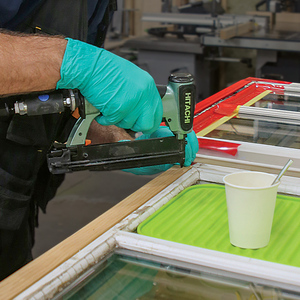I recently installed 3/4 X2 1/4 Red Oak T&G flooring,Select & Better grade.
I did the install myself but chose to have the sanding and finishing done by a hardwood flooring professional. They have done a beautiful job on the sanding.
My problem is with the stain. Staining was done on Thursday 7/3. Miniwax oil-base stain was used. There is some un-evenness in the absorption in some of the boards. Obviously I expect variation in color from one board to the next due to differences in grain, etc. However, there are several boards where the color trails off at the end of the board and is much lighter. I think they might have been moving a little too fast and wiping it up before the stain had a chance to penetrate.
Can more stain added to corrected this (without darkening the color significantly) or without sanding to bare wood again?
They are returning tomorrow morning to apply the first coat of polyurethane.
FYI, The wood was allowed to acclimate for for several weeks prior to install & I let the floors settle out for three weeks before sanding.



















Replies
If they have not applied any sealer (urethane, varnish, whatever) then there is a very good chance that any color variations can be worked out. Note that if you apply more stain, then you have to wait a certain period of time before apoplying sealer, especially with oil based stain.
Do it right, or do it twice.
Thanks. No polyurethane yet. It's scheduled for tomorrow but I want them to work out the stain first.
Any idea how it should be done? Is it simply a matter of applying more stain or will it need to be screened or sanded first ? and if so the whole floor or just the lighter areas?
Thanks, Paul
we had similar but far more troubling issues with a red oak floor about a year ago that kept bleeding stain up into the finish. the stain color required two applications of stain which were a blend of lots of colors. yes, you can do this. you need to screen lightly between coats. i think our sanders used a worn out red pad. i would be leery about spot screening and staining to even color. you can try it and if it doesn't work you can lightly screen the whole floor before you restain. the guys used a brush on the first stain coat and a lambswool on the second. in our case, waterlox tung oil was blended with the stain on the first and second coat to help the stain set. you don't have to do this.
carpenter in transition
Closely inspect the boards where the color seems to trail off. Do those parts of the boards contain more summer wood? Spring and autumn wood will accept stain more deeply than that of the more dense summer wood.
Is your floor southern or northern red oak? If you installed the southern variety expect much more grain seperation between growth periods....and more uneven stain coverage.
Ditch
I can't help you out much on the stain question, but I do have comment/question on your next step. When I done my floor, I stained, then sanding sealer, light sanding and then the poly. I I think that I got a much better finish using the sanding sealer. Oak has a very open grain and the sealer does a good job of filling that before the final coat. I know that on the furniture pieces that I do it make a big difference in the finish.
My two cents....
I would do what the cabinet makers do, and put some compatible stain in the polyurethane. This is known as a toner coat and is used to even out color and tie the whole surface together. It will make the floor somewhat darker. If that is unacceptable, you can use a toner coat over the light areas only. Its more likely to result in an even color than resanding and recoating with stain. Check with some of your local wood finishing experts, they can tell you how to do it. Mixwax, by the way, is avoided by the cabinet makers for lots of reasons, among which it doesn't stain too evenly.
I would have them use the same type and color stain but since the areas need to be darkened, I like to use the bottom 2" of the can, where the pigment is. Pour off the top 3" and with a brush loaded and primed with this bottom stain (which is darker), practice on a piece of scrap, and hopefully that color will be dark enough. Apply to the pieces that need to be darkened carefully and only on those areas. If it is too dark, then take a dry brush and lightly brush off the stain until the color is fairly close.
2-3 coats of poly will even up the color variations even further after your work. I don't know why, but that is the case. You will be amazed at how the color variations disappear when finally finished.
Regards,
Boris
"Sir, I may be drunk, but you're crazy, and I'll be sober tomorrow" -- WC Fields, "Its a Gift" 1934